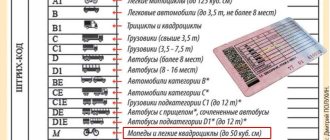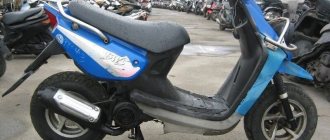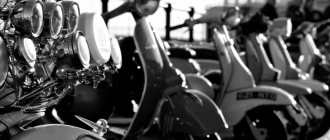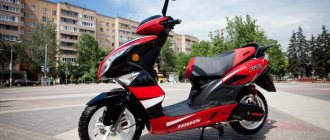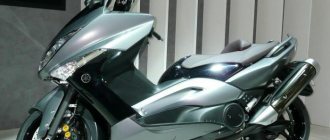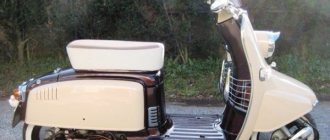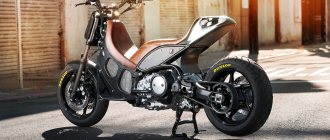The scooter market is full of variety. Chinese manufacturers occupy a significant share of it. Honling Caper is one of the representatives of 50 cc scooters. At its core, this is a restyling of the Honling Joker 50. It differs from its predecessor in 12-inch wheels, a double seat and the presence of a trunk.
| Engine volume, cm3 | 49,9 |
| Power, hp | 3,5 |
| Number of cylinders | 1 |
| Number of cycles | 4 |
| Maximum speed, km/h | 60 |
| Gasoline consumption, l | 1.5 l/100 km |
| Tank volume, l | 5 |
| Transmission | Variable speed drive |
| Dimensions d/w/h, mm | 1850/680/1020 |
The scooter is equipped with a four-stroke single-cylinder 139 QMB engine with forced air cooling. With its 50 cc it produces 3.5 hp, which is quite a bit with 100 kg of dry weight. Just like all scooters, a variator is installed.
The suspension is reliable, copes well with uneven roads, and the ground clearance of 200 mm and 12-inch wheels allow you to drive through defects in the road surface without fear of getting caught in the protection. There is a telescopic fork installed at the front, and a pendulum suspension with two shock absorbers at the rear.
The brakes, like for a Chinese scooter, are surprisingly grippy: the front ones are disc and the rear ones are drum.
The instrument panel is easy to read and has no frills. It accommodates a speedometer with an odometer, a fuel level sensor, turn indicators and an electronic clock. There is a small visor above it, which allows you to perfectly read information without sun glare. Since 2008, the Honling Caper 50 has been equipped with an alarm system that can not only protect against theft, but also tell the driver about the actions he performs while driving.
The design of the scooter is very unique. A large two-seater seat, combined with a slight tilt of the steering fork, provides a comfortable fit , and allows you to travel a decent distance without experiencing any particular inconvenience. The set includes a case in which you can freely put a helmet.
How to choose the right cheap scooter?
First of all, I would like to note that such vehicles are often used not only for driving in urban areas, but also for long trips. Today, specialized stores offer scooters from a variety of manufacturers, so choosing a vehicle to suit your needs is not as difficult as it might seem at first glance. It can be ridden by both men and women, as well as teenagers.
The first thing you should pay attention to when purchasing is engine power. Many buyers are guided by the following principle: the more power, the better. Indeed, such equipment is more comfortable to drive both on city roads and on highways; it is distinguished by decent maneuverability. The manufacturer is also taken into account. For example, it has long been proven that Western European and Japanese options are much more reliable and durable compared to Chinese products.
How to choose the right scooter and not make a mistake
Engine size is also important. It must be remembered that to control a scooter with an engine capacity of 50 cc. cm or more, you will have to obtain the appropriate category of driver's license. Japanese versions are usually not very powerful - about 50-70 cc. cm. European brands produce products with increased volume: it ranges from 70 to 250 cubic meters. cm.
Most modern scooters are produced with four-stroke internal combustion engines. These engines consume little fuel, are not very loud, produce virtually no pollution, are easy to control and have excellent maneuverability. However, scooters with such motors will cost significantly more than products equipped with two-stroke engines. The latter are characterized by increased fuel consumption, they do not have a separate tank for motor oil - it will need to be poured directly into the gas tank, however, scooters with such an engine are unpretentious in maintenance and are characterized by a simple design. Their maximum engine capacity does not exceed 50 cc. cm.
When we chose products to include in the review of the best cheap scooters, we mainly took into account the points discussed above. However, we also took into account some other factors, such as user reviews and value for money. We hope that after carefully studying our review, you will be able to choose the best option for yourself, which will help you move quickly not only in urban conditions, but also on the highway or off-road.
The lack of availability of 10/3 Watt light bulbs in the area and the not entirely acceptable performance of the common 21/5 Watt bulbs forced us to take up “farming”. If this is relevant to anyone, please read further. If anyone has seen the Honling Cruiser QT-8 scooter, they will have noticed that it has double brake lights. For those who haven't seen it, the photo from the sneaker confirms it.
The stock lamps had 12 Volt 10/3 Watt bulbs. Their use is quite understandable; the generator in the scooter is not the Bratsk Hydroelectric Power Plant. Nevertheless, the light bulbs burned out, and there was nothing to replace them with, since there were stupidly none in the surrounding stores or on the Internet, because the product was not selling. After installing 21/5 Watt lamps, another unpleasant detail appeared - a current of slightly less than 4 Amps flowed through the brake switch (42 Watts after all), as a result of which about 3 Volts dropped on the “wah”, which is not very good, and led to replacement switch (two in three years). The appearance of LED lamps on sale helped solve this problem. Baseless lamps of the “corn” type were found on sale in three types of different “storeys”. We buy “one-story” ones for dimensions, and two/three-story ones for the brake signal. In the latter case, we look at which light bulb will fit into the space intended for it; in my case, a maximum of two-story ones fit into the lantern. The power consumption of the two-story “cob” is 1.2 Watts, which is approximately 10 Watts emitted. We proceed in the following order. I didn’t take pictures of the process, because I first made it, installed it and tested it, and only then remembered about the camera, but from the title photo, I think the general design will be clear. 1. Remove the “cobs” from the plastic holders. 2. Cut out square plates 2x2 cm from one-sided foil PCB or getinax. 3. Place lamps on the plates in such a way that the “positive” terminals are closer to the center, and the lamps themselves stand at corners to each other, without overlapping the LED emitters. We drill holes, solder the “negative” terminals to the foil, isolate the “positive” terminals from the foil and let them stick out further. 4. We free the bases of the burnt double-filament lamps from the remains of the bulb, and clean the holes in the contacts. We place the bases on the foil side, push the insulated leads into the contacts (of course, we remember which goes which way) and solder them. 5. After checking, we attach the “cobs” to the plates with hot glue. In terms of its dimensions, the result turned out to be completely similar to a 21/5 Watt lamp. The disadvantage of the design is that only lamps with milky-white LEDs were found on sale, which gives a slight purple tint to the glow in the lanterns. I’d like to find red “corns”... If someone has a concern that, they say, the brightness of the standard lights may be insufficient, then in this case I have installed (look at the second photo): - outwardly it looks like a red reflector under the lights, however, this is an additional size and a brake light from the Chinese brothers (something like this, but the price at the time of purchase was much lower); — two meters of red LED strip with a power consumption of 7 Watts (approximately 40-45 Watts emitted) are glued into the reflector of the case. From the sneaker you can see it something like this:
and is located at eye level behind the average driver driving in a car, so the illumination during braking is quite sufficient and noticeable, however, standard lights also play an important role. Good luck to everyone and smooth roads!
